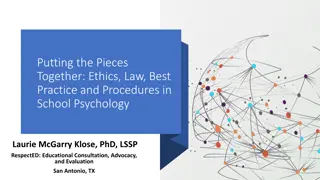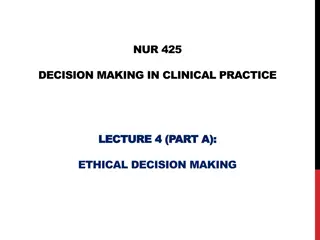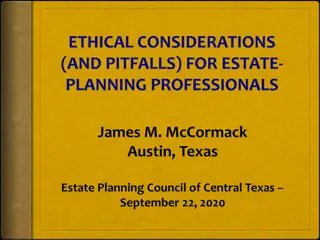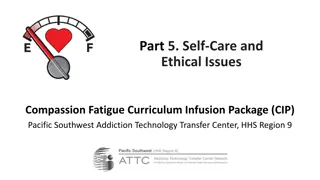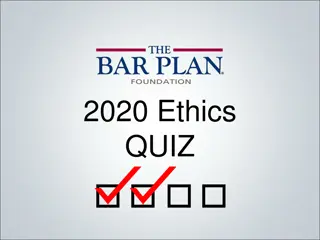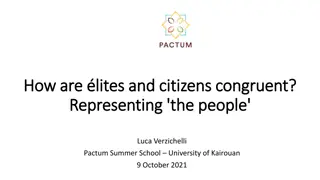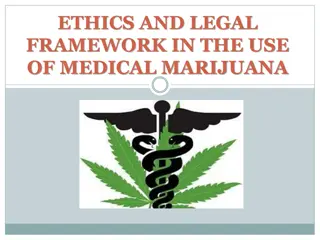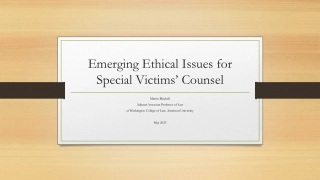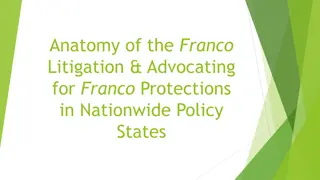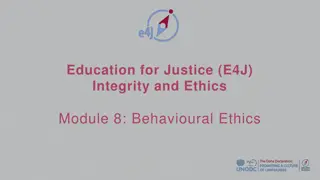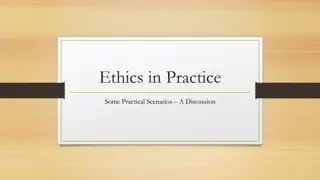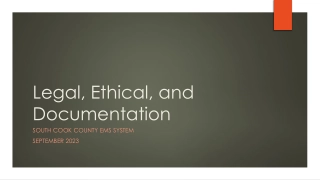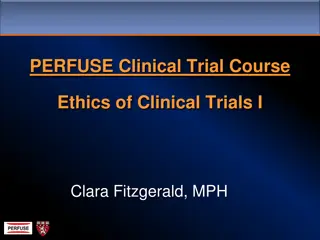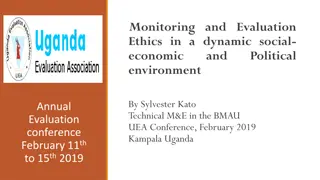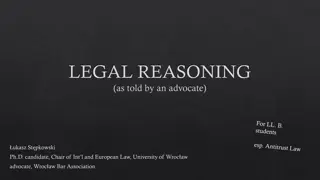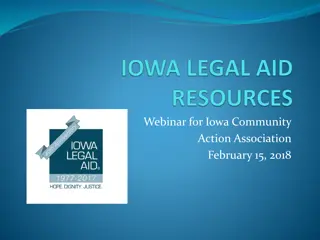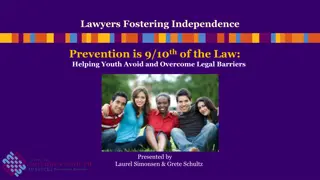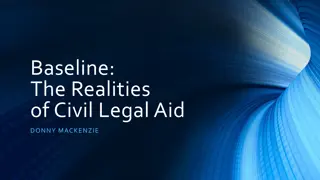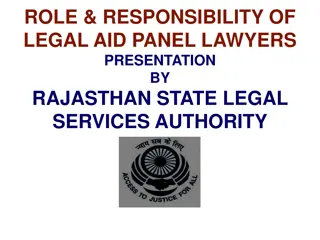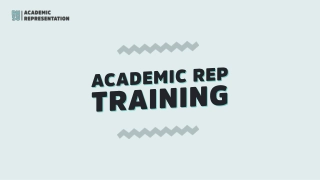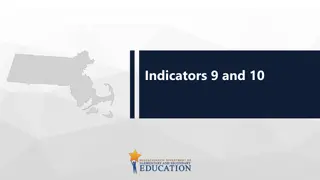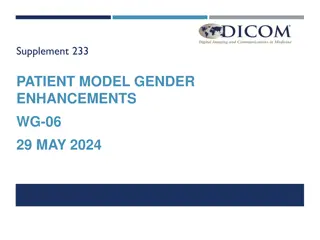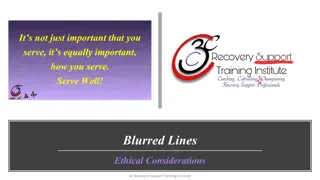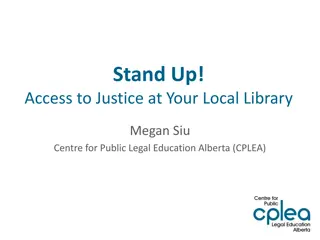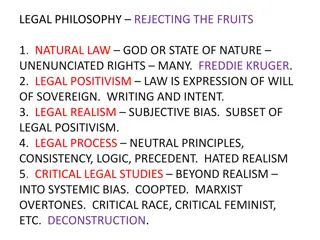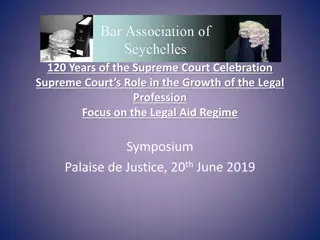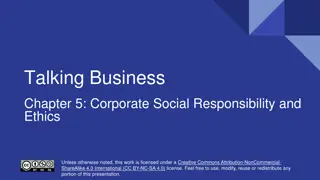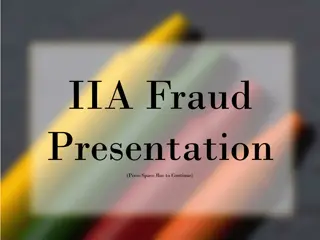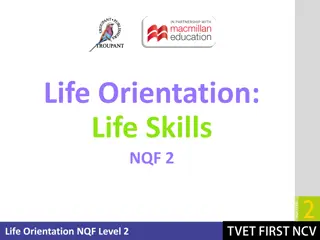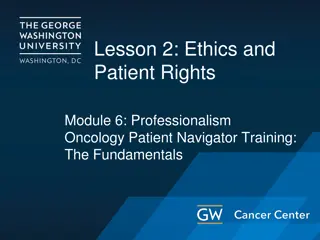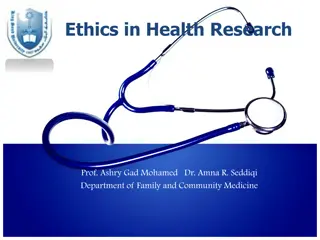Ethical Considerations in Legal Representation
Lawyers should provide holistic advice to clients, considering moral, economic, social, and political factors, not just legal aspects. Ignoring emotional dimensions may hinder effective representation, while embracing rehabilitation programs can empower clients. The American Bar Association encourages alternative sanctions for a more flexible criminal justice system.
Download Presentation

Please find below an Image/Link to download the presentation.
The content on the website is provided AS IS for your information and personal use only. It may not be sold, licensed, or shared on other websites without obtaining consent from the author. Download presentation by click this link. If you encounter any issues during the download, it is possible that the publisher has removed the file from their server.
E N D
Presentation Transcript
James S. Egar Monterey County Public Defender
In representing a client, a lawyer shall exercise independent, professional judgment and render candid advice. In rendering advice, a lawyer may refer not only to law, but also to other considerations such as moral, economic, social, and political factors that may be relevant to the client s situation. 2
Advice couched in narrow legal terms may be of little value to a client, especially where practical considerations such as cost or effects on other people are present. Purely technical legal advice, therefore, can sometimes be inadequate. It is proper for a lawyer to refer to relevant moral and ethical considerations in giving advice. Although a lawyer is not a moral advisor as such, moral and ethical considerations impinge upon most legal questions and may decisively influence how the law will be applied. 3
Attorneys who ignore the emotional dimensions of dealing with clients in this context (sentencing) risk a serious loss of effectiveness in representing them at plea bargaining and sentencing. They also risk alienating clients who might interpret their lack of interest in the emotional aspects of the situation as coldness, insensitivity, callousness or even antagonism. Clients tend to be more distrustful of such attorneys and are less likely to cooperate fully with them, to have full and frank communications with them, and to value their advice. Redefining the Role of the Criminal Defense Lawyer at Plea Bargaining and Sentencing. A Therapeutic Jurisprudence/Preventative Law Model, Prof. Bruce J. Winick, University of Miami School of Law 4
Clients can be energized with a sense of power by entering a rehabilitation program. A client and defense attorney can create facts and documents, testifying expert witnesses, testifying factual witnesses and positive theme for a case all through the defendants efforts. 5
The American Bar Association Standards for Criminal Justice Sentencing (3rd Edition, 1994) encourages the use of alternative sanctions instead of total confinement in prisons and jails or probation to cerate criminal justice systems that are more flexible, responsive and effective. 6
Beneficence: Promote good Non-malfeasance: Do no harm Autonomy: Respect freedom of individual to control own life Justice: Treating fairly Fidelity: Keeping promises, real and implied 7
Teleological: Which action results in the most good or least harm? Deontological: Which action supports your highest ethical principle? 8
You realize that doing the best thing for your client means getting the best life outcome, not simply the best legal result. If we re successful in getting them off drugs, this would eliminate the necessity to commit crime. Everybody wins when you do it that way. That is the genius of this program. Michael Judge, Los Angeles County Public Defender Michael Judge, Los Angeles County Public Defender 9
73% of Chiefs of Police say that mandatory minimums for drug possession are only somewhat effective in their communities 59% of Police Chiefs favored treatment over prison for drug abuses Hart Research Survey (1996) Drug are the underlying cause of almost all serious crime in the United States. Police Chief Mid-Sized Eastern City. 10
State Law 42 C.F.R. Sec. 2 U.S. Code Title 42, Section 290dd-2 11
When the program and/or court involves substance abuse education, prevention, treatment rehabilitation or research Treatment program is one that holds itself out as providing, or provides substance abuse Diagnosis Treatment Referral for treatment Program is regulated or assisted directly or indirectly by the Federal government 12
Recorded or not recorded Somehow makes it possible to identify the participant Reveals that participant is , has or has applied to receive substance abuse treatment Further disclosures Re-disclosures 13
Knowing and voluntary In writing Participants name Identifies who is permitted to disclose Identifies to whom disclosure can be made Purpose of disclosure 42 C.F.R. Sec 2.31(a) 14
How much and what kind of information Participant/authorized person s signature Date of signature Revocation statement Date, event, condition, upon which consent is revoked 42 C.F.R. Sec 2.31(a) 15
Advise participant, orally and in writing of Federal protection of confidentiality Present and review consent form (consider literacy and language) and implications Cultural competency Participant should have opportunity to consult with a lawyer prior to signing 16
Re-execute consent at least once Ensure all necessary people are listed in consent form Storage of records Not public records Written procedures for access Locked or secured room Even permitted disclosures are limited to needed information 17
Drug courts integrate alcohol and other drug treatment services with justice system case processing Using a non adversarial approach, prosecution and defense counsel promote public safety while protecting participants due process rights Eligible participants are identified easily and promptly placed in drug court program Drug courts provide access to a continuum of alcohol, drug, and other related treatment and rehabilitation services Abstinence is monitored by frequent alcohol and drug testing 1. 2. 3. 4. 5. 18
A coordinated strategy governs drug court responses to participants compliance Ongoing judicial interaction with each drug court participant is essential Monitoring and evaluation measure the achievement of program goals and gauge effectiveness Continuing interdisciplinary education promotes effective drug court planning; implementation, and operations 10. Forging partnerships among drug courts, public agencies, and community based organizations generates local support and enhances drug court effectiveness 6. 7. 8. 9. 19



